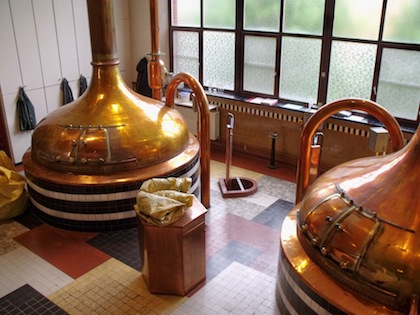It’s every beer lover’s dream, to jump in the Time Machine, spin the dials and travel back to discover what iconic brews were really like centuries ago: the IPAs of Victorian England, the porters and stouts of 18th-century London, and, when the church once held sway, the robust ales made by monks.
Westmalle can only satisfy the demand for its beers in Belgium, the Netherlands, France and Britain. At present, the monks have no plans to export to the United States. All you can do is pray...
But, stop the world, I want to get off. There are still monks firing their mash tuns and kettles, continuing a tradition that was once the norm throughout the Christian world. Today, in Belgium, Trappist monks take time from their prayers to make small batches of ale of the highest quality, ales that are promoted by word-of-mouth, not advertising. To visit a Trappist brewery there is to take that journey back in time, when the pace of life was slower and more thoughtful, and the driving force was the pursuit of communal work, not commerce.

Brewing in the Dark Ages
In an age of global brands and mass advertising, it’s easy to forget that for centuries brewing was confined to the home and the church. The spread of Christianity dampened some of the wilder excesses of the Anglo-Saxon period as the church attempted to regulate drinking and to control the production of ale. Monasteries offered accommodation to travelers while the monks built their own brew houses to supply both pilgrims and priests. At a time when was water was unsanitary, vitamin-rich ale was an important part of the monks’ frugal diet. The usual ration in a monastery was eight pints a day of “small beer”—around 3 percent alcohol—for each monk. Production was prodigious. The malt house at Fountains Abbey in Yorkshire, northern England, was 60 square feet in size and the brewery made 60 barrels of ale every 10 days.
And the ale must have been of good quality. In 1158, the priest Thomas Becket, later to become Archbishop of Canterbury and famously murdered in his cathedral, took two chariot loads of ale with him on a diplomatic mission to France, “decocted from choice fat grain as a gift to the French who wondered at such an invention—a drink most wholesome, clear of all dregs, rivaling wine in color and surpassing it in savor.”
The power of the church in society and its near stranglehold on brewing was broken in the 16th century by two key figures in European history. King Henry VIII of England and Martin Luther in Germany were contemporaries, living from 1491 to 1547 and 1483 to 1546 respectively. Henry dissolved the monasteries because he needed the monks’ wealth to fill his depleted coffers while Luther set in motion the Reformation that led to the rise of Protestantism. In both countries, trade replaced feudal land ownership as the way of life. As a result, commercial brewing developed rapidly and the monks shuffled off the pages of history.
Sticking to Tradition
But in the countries that remained faithful to the old religion, change was far slower. In Bavaria, for example, now the southernmost region of Germany, the world’s oldest brewery is in the former monastery of Weihenstephan (Holy Stephen), which was not secularized until 1842. In Munich the Paulaner brewery, acclaimed for its bock beer, also remained in church hands until the 19th century. Monks at the Benedictine monasteries of Andechs and Weltenburg still brew, though they have adopted modern lagering techniques.
It’s in Belgium that the ancient tradition of ale brewing by monks still survives. The abbey of Westmalle, a few miles north of Antwerp, is one of six Trappist monasteries in the country that still make beer. The monks find that their exquisite ales are talked about and sought after by a growing number of discriminating drinkers throughout the world. Westmalle is especially highly regarded, as the abbey has given names to its main products—Dubbel and Tripel—that have become recognized styles. The abbey’s double and triple are frequently copied but rarely if ever surpassed.
The abbey’s full name is Our Beloved Lady of the Sacred Heart. An arrow-straight, narrow road from the village of Westmalle leads to the buildings half-hidden by tall elm trees that act as sentinels against the outside world. Away from the roar of traffic on the Antwerp-Turnhout road, you are struck by the silence and solemnity of the majestic abbey and its grounds. The only sound is birdsong. The word “stilte” (silence) appears on many doors—visitors are greeted by the monks with warm smiles and a finger to the lips.
Westmalle is, fundamentally, a place of worship and contemplation. The monks follow the simple edict of St. Benedict: ora et labora—pray and work. A few words are spoken to visitors but silence is the rule. It was a strange experience to eat both supper and breakfast without exchanging a word with my fellow diners. The atmosphere is quickly absorbed and I found myself tiptoeing down corridors and closing doors as though they were made of fragile glass.
One aspect of the abbey was familiar to me: the delicious aroma of toasted grain and yeast that told me beer was being made. At the rear of the abbey, the brewery stands in sharp contrast to the rest of the buildings. The characteristic symmetry and curves indicate that the brewery was designed and built in the 1930s in the Art Deco style of the time.









